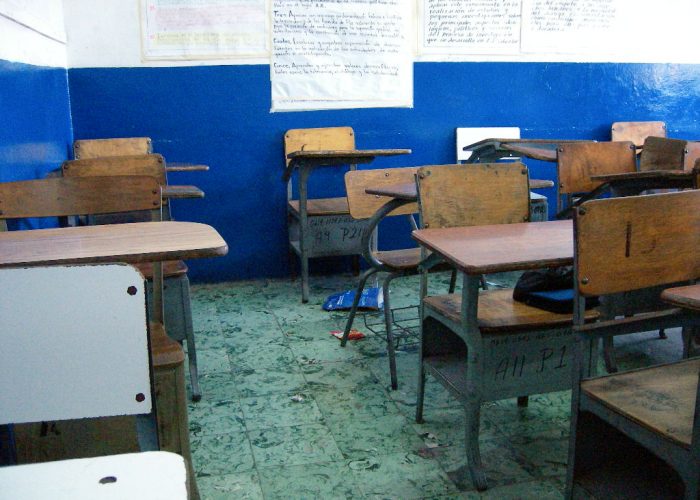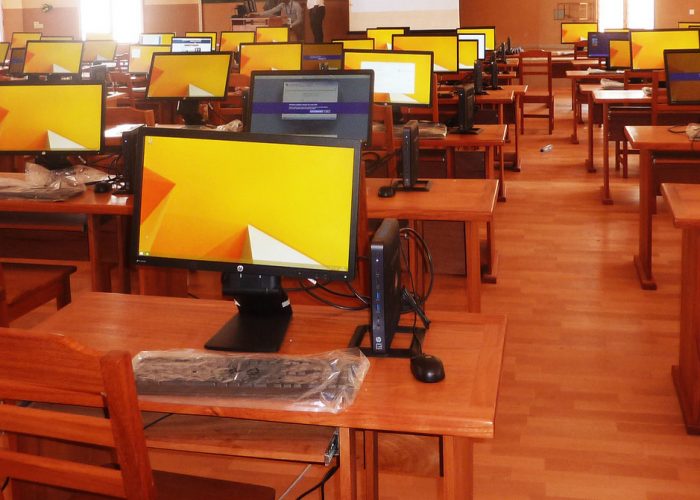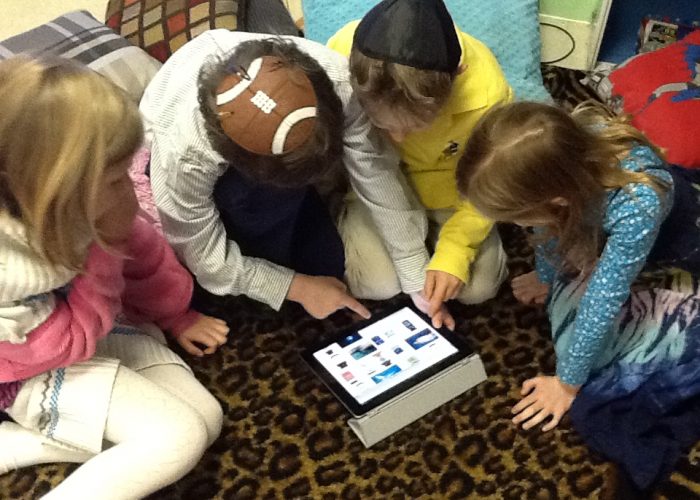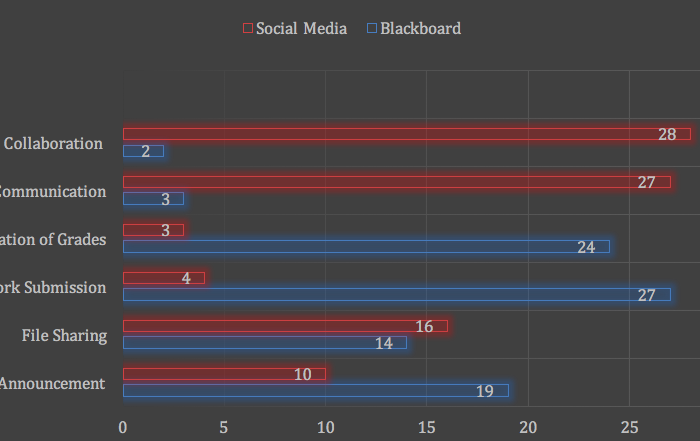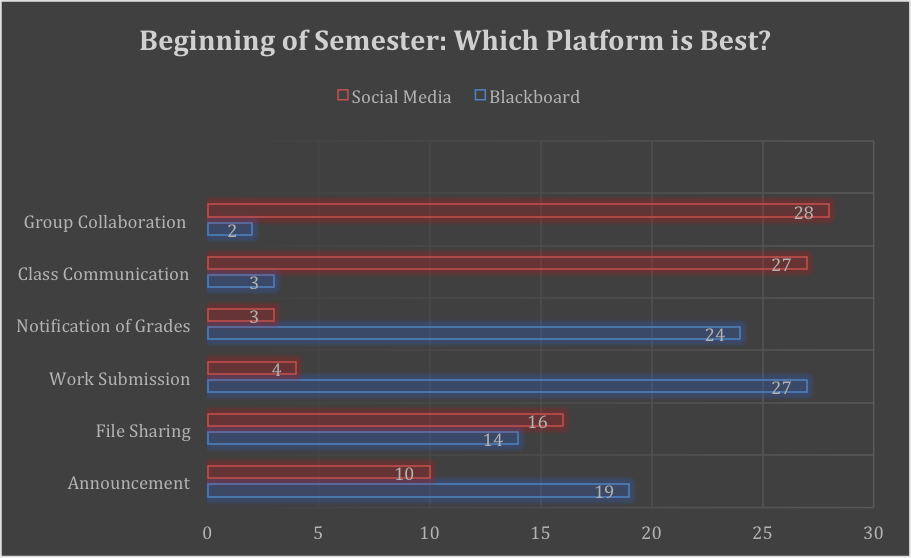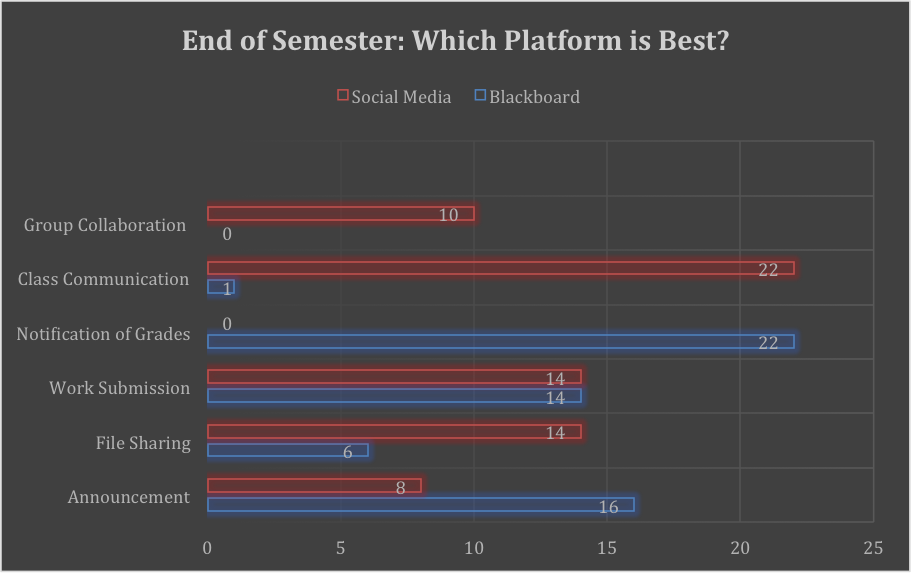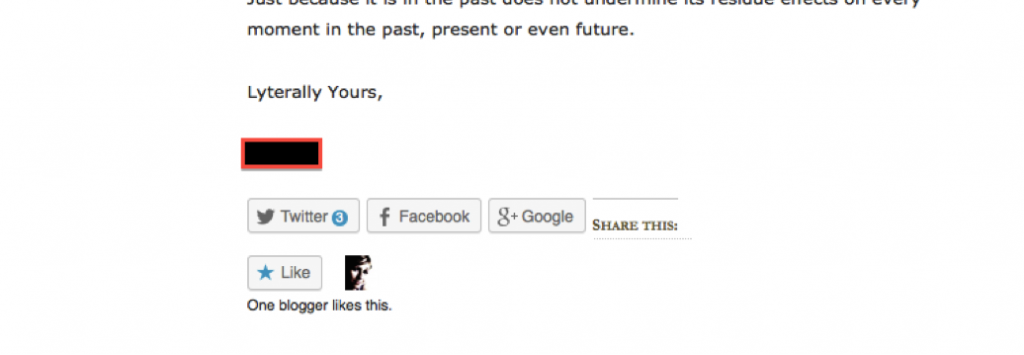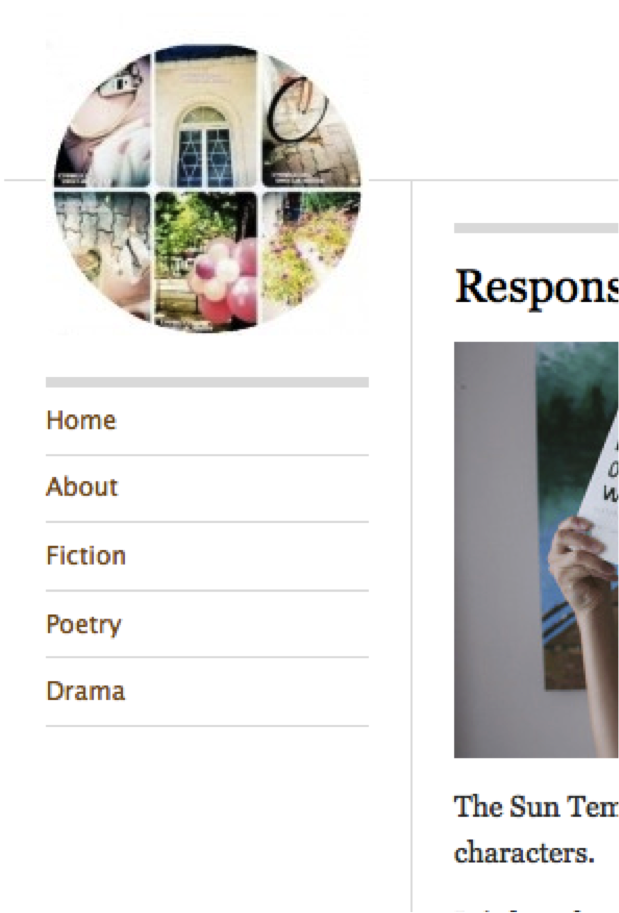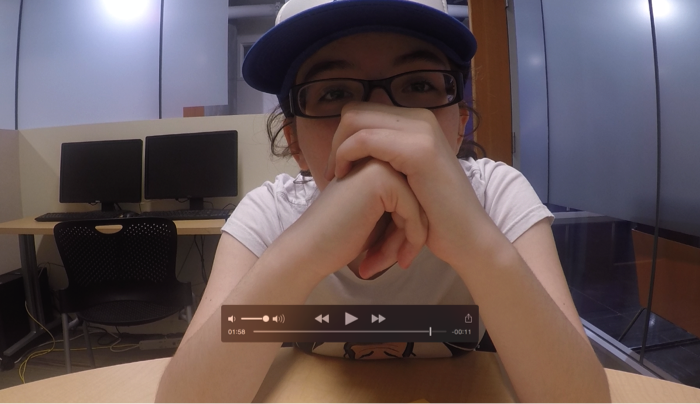Emma J. Rose, University of Washington Tacoma
Jarek Sierschynski, University of Washington Tacoma
Elin A. Björling, University of Washington Tacoma
Abstract
Reflection is commonly used in the classroom to encourage students to think about and articulate what they have learned. However, when students produce reflections they typically create a written text for the instructor, outside of the classroom and as a summative retrospective account of learning. In this paper, we present the details of how we implemented Ecological Momentary Reflection (EMR), a video enabled reflection within the classroom environment to help students assess their perceptions of self and learning across time. In this paper, we recount how we implemented EMR in an informal learning environment and provide our own assessment of its effectiveness. We argue that using video makes the reflection experience more authentic and meaningful for both student and teacher.
Introduction
Reflection is commonly used in the classroom to encourage students to articulate what they have learned and to aid them in thinking about how they have learned. Traditionally, students reflect on their learning process through the act of writing. According to Yancey, written reflections benefit students by helping them remember details of how they completed an assignment, as a generative process to create meaning for future writing, and as a way to develop authority and expertise (Yancey 1998). While written reflection has its strengths, it also has some inherent limitations. Written reflection is typically geared toward oneself and is often produced as a text for the audience of the instructor — perhaps limiting the student’s authenticity.
Moreover, writing is a form of culturally constructed expression with its own peculiarities (see, Chafe 1991; Chafe & Tannen 1987) that simultaneously differentiate and distance written texts from more direct or immediate forms of communication such as speech, sign or gesture. Even though texts are a profound means of representing human thought and introspection, the process of writing a text can become an impediment to self expression. For example, when writing skills are underdeveloped, not available, or stymied by other factors, writing can be limiting rather than productive. Additionally, much of the writing process relies on drafting and revising, a reiterative process aimed at clarifying expression and distancing the writer from the initially captured “raw” and momentary expression. At the same time, it can be argued that the strength of writing as a reflective tool lies precisely in a symbolic and temporal chasm between the individual and experience that nurtures reflection.
Given the benefits of the reflection process, and the inherent downsides of written expression, we wanted to explore a mode of reflection that could be incorporated authentically into the context of science learning in an informal setting, in this case during a summer STEM (Science, Technology, Engineering, Mathematics) camp for teens. We ground our use of the term, authenticity, in Buxton’s (2006) framework for authenticity in science education. He conceptualizes a youth-centered model that focused on the lives and learning of underserved and marginalized youth and thus on equity and social justice (see Medin & Bang 2014; Barron, Mertl & Martin 2014; Barton 1998; Barton & Young 2000; Nasir & Cooks 2009). These youth-centered models view authentic science learning and knowledge as a sociocultural process situated in lived experiences, such as cultures, identities, communities, homes, and the wide range of informal environments where learning occurs. Implementing a reflection method that leverages the experience of the community and captures reflection in context was synergistic to the authentic, youth-centered model of learning at the heart of the summer STEM summer camp experience we were investigating.
To create an integrated and authentic notion of reflection in the learning environment, we introduced an exercise that asked students to record a series of videos. Adding video to the reflection process helped students see that their thoughts about themselves and the STEM subjects have changed. This activity also layered an additional element of a shared and community based reflection to the learning experience. Furthermore, the video reflections provided instructors and program directors with an authentic representation of the students’ struggles and triumphs throughout the duration of the camp. These factors helped students see their own learning and helped instructors in getting feedback on the course to inform future improvements of the camp.
In this article, we provide our own reflection on the process of introducing a new method of reflection into a learning environment. The aim of this article is to introduce the concept of Ecological Momentary Reflection (EMR) and to recount its effective use in an informal STEM learning environment. We propose that the addition of momentary, that is in the moment, video to capture real-time student reflections in the classroom provides an authentic reflective practice leading to valuable insights for both learner and instructor. First, we articulate the context of the learning environment where we implemented EMR. Second, we define reflection as a pedagogical practice and how it is used in writing and how video can support reflection on practice. Third, we provide details of how we implemented video reflection in the summer camp, a method we are calling Ecological Momentary Reflection (EMR), and invite educators and researchers to consider this method of reflection in their own teaching environments.
Context: Informal Learning in a STEM Summer Camp
Every summer at a Pacific Northwest University, middle and high school students come together for a summer camp that is focused on learning about STEM (science, technology, engineering and math). The STEM camp mission is to encourage and increase diversity in STEM fields by providing informal learning experiences for students (grades 7-12) that remain underrepresented in the sciences. Underrepresented groups included low-income, minority, female and potential first-generation college students, among others. The campers who attend the STEM Camp tell us they are drawn to it year after year because it is fun, and ‘you get to do things’. Participants build robots, design video games, wade out into the muddy banks of our local waterways to collect water samples, and more. It is a break from school and existing social pressures; it is a safe place. Students make new friends and deepen existing relationships as they interact with their peers, some who return each year.
Informal learning is a broad concept that refers to any learning that occurs outside of the formal realm of school (Dierking et al. 2003). Informal learning includes people engaging with their environment in a variety of contexts and settings. Learning experiences that are designed for broad audiences (i.e., museums, summer camps, etc.) are considered types of informal learning both inside and outside of the STEM disciplines. In these settings, informal learning tends to be momentary, unplanned, problem-based, learner-centered, driven by individual interests (National Research Council 2009). Many STEM summer camps can be categorized as informal learning environments in that they promote experiential learning and exist outside of the realm of formal schooling. The camp instructors include current college students or professionals such as educators or scientists from the local community. The authors of this article were involved with the STEM camp in the roles of faculty mentors to the instructors.
It is within this informal learning setting that we implemented EMR as both a pedagogical tool and a research method aimed to enable students to reflect on their changing identities as well as their relationship to STEM subjects. In the Summer of 2015, we conducted an IRB approved research study where we used EMR with 9th grade participants in the STEM camp. The students spent three weeks designing a video game using Kodu, a visual programming language. In this paper, we focus on the promise of EMR for use as a pedagogical tool in the classroom.
Reflection as a Pedagogical Practice
Reflection is a common pedagogical practice where students are asked to think about and articulate what they have learned. Reflection has long been viewed as synonymous with thinking and learning (Dewey 1933). Moreover, reflection is considered a core element of metacognition. Metacognition, a multifaceted term connected with reflection, refers to knowledge about, and the regulation of, cognitive processes such as self-regulated learning (Brown, Bransford, Ferrara, and Campione 1983; Flavell 1979; Zimmerman 2002). In other words, metacognition is a student’s awareness of how to learn and also an awareness of herself as a learner. Metacognition is also connected to students’ ability to transfer their learning across contexts (Bransford, Brown & Cocking 2000). In K-12 settings, both elements of metacognition, knowledge of strategies associated with specific academic tasks (such as reading, writing or math) and self-regulatory strategies (such as self-monitoring or self-evaluation) are commonly used in teaching and learning tasks. There is a rich variety of established pedagogical approaches that apply metacognitive strategies for learning. For instance, in writing, students use think-aloud and self-questioning strategies (Scardamalia, Bereiter & Steinbach 1984). In reading, students self-monitor to check for comprehension through questioning, summarizing or making predictions about a text (Palincsar & Brown 1984). In math, students can use self-assessment to evaluate their own mathematical capabilities (Schunk 1996). These strategies have been associated with increased achievement and also with higher self-efficacy (see Schunk 1996). Furthermore, reflection often occurs as an important process in the development of expertise. Looking at how expert practitioners engage in their work, Schön observes: “Reflection tends to focus interactively on the outcomes of action, the action itself, and the intuitive knowing implicit in the action.” (Schön 1982, 56).
According to Yauncey (1998), reflection is both a process and product and the product that is created is available to the world and is therefore a social act. She states, “because it works both inside and outside, reflection-in-presentation is personal, but it’s social as well” (Yancey 1998, 94). However, in the writing classroom, a reflection tends to be a written text, constructed by a student for the instructor and often disregards this social aspect referred to by Yauncey. When produced for the sole audience of the teacher, written reflections can pressure students to attempt to perform the type of writing expected by the teacher: demonstrating what they should have learned rather than reporting on what they actually learned (Jenson 2010).
Ecological Momentary Reflection
Our goal in implementing video enabled reflection in the classroom was twofold. We wanted to see how students’ ideas about and in relation to STEM were impacted by their experience in the STEM camp. But we also wanted students to see how their perceptions and attitudes may have changed over time. We wanted the reflections to be as natural, immediate and embedded as possible within the practices of the camp. We wanted the reflections to be as close to the learning experience as possible, both in terms of the timing of the reflections and where the reflection would take place. In other words, we wanted them to be momentary (i.e. quick and timely) and also ecologically valid (i.e. within the environment where learning is taking place). This rationale for this embedded aspect of the reflections was driven both by our research focus but also by past experience.
The design of our reflection method is drawn from an approach used in behavioral health, medicine and psychology known as Ecological Momentary Assessment or EMA (LaCaille et al. 2013). In EMA, research participants provide feedback on symptoms, feelings, or other measures in real time and these assessments are often repeated over time. This real time reporting is enabled by a variety of technologies, such as mobile phones. As proponents of EMA report, its strength is in the authentic context where the research takes place and the ability to capture data as it happens (Shiffman, Stone, and Hufford 2008). Additionally, EMA has been proven an effective method to capture change within individuals and avoids the “pitfalls and limitations of reliance on autobiographical memory” (Shiffman, et al. 2008, 7).
Based on our previous experience in the STEM camp, we had limited success with interview methods with students. Although we had seen the students’ progress in a variety of ways, their own assessment of their experience did not include an expression of awareness of these changes. We also felt that the interview environment seemed superficial and separate from the classroom activities, likely influencing the authenticity of the students’ responses.
As a result, we designed our methodology to be informed by the concept of reflection and also containing the ecological and momentary characteristics of EMA. Because of our use of video to capture student reflections in the moment we named this method Ecological Momentary Reflection (EMR).
Implementing EMR in the Classroom
In the summer of 2015, we worked closely with the 9th grade cohort of the STEM camp program and their instructors to implement the EMR method. We explained to students that they were creating the videos for themselves but also for each other as a way to reflect on their learning and to capture their experiences at summer camp. Therefore, students were aware there was a larger audience for the reflections. Students were also told that highlights of the reflections would be compiled and they would watch this highlight compilation together on the last day of the camp. They were given digital copies of their personal reflections, their group videos and a copy of the final edited compilation to take home with them as a keepsake from their camp experience.
Students created three video reflections during the three-week summer camp: an introduction, mid-point, and final reflection. For the first reflection, students created an introductory video. They were asked to introduce themselves, talked about their hobbies or interests, and reflect on how they felt about STEM and about themselves. In the second video reflection, students were given two photographs of themselves from previous days at camp that captured them engaging in one of the main STEM camp practices, in this case coding a video game on a computer. Students were asked to reflect upon what they were doing in the photo, how they felt looking at themself and what the photographs reflected about them as individuals. In their final reflection, which took place at the beginning of the third week of the camp, the procedure was slightly different. Students watched the previous two reflection videos and were then asked to respond via video to the experience of watching themselves and how they changed over the course of the summer camp. The specific wording of the prompts is shown in Table 1 below.
| Topic and timing |
Prompts |
| Video reflection 1: Introduction (Day 1)
|
Introduction reflection
1. Who are you:
What do you like to do? What makes you special?
2. You and technology:
Do you think of yourself as a technical or computer person? Why or why not?
Do you think other people in your life (friends or family) see you as a technical or computer person? Why or why not?
3. Complete this sentence: By the end of STEM camp this summer I expect…. |
Video reflection 2: Photo reflection
(Day 8) |
Photo reflection
During one of the early days when students start coding they will photographed while they are working. The photograph will serve as part of the prompt:
1. How would you describe what you are doing in the photographs? How does this fit into the rest of your life?
2. Can you talk a little about what you feel and think when you look at these photographs?
3. What do these photos reflect about who you are?
4. What can somebody looking at these photos learn about you?
5. CHALLENGE—Come up with your own prompt (question for self) related to the photos and try to answer it. |
| 3. Video reflection 3: Wrap up (Day 14_) |
Final reflection:
After watching the video of yourself from the start of the program, answer these questions:
1. What do you think after watching that video?
2. Do you see yourself any differently from when you started STEM camp?
3. Have you learned anything new about yourself?
4. What was the best and worst parts of STEM camp?
5. What surprised you about this experience?
6. Please complete the following sentence. “After participating in STEM camp this year, I feel that I… “ |
To create an appropriate space for the video reflections, we used a small, quiet, private room just outside of the main classroom where students were spending their days. The room was equipped with a GoPro Hero 4 camera and students could move or adjust the camera based on their comfort level (Figure 1 shows the room set up).

Figure 1: Video reflection room set up with camera and prompts.
Our motivation for creating a private space adjacent to the classroom was to give students a place to be able to quietly reflect while still being close to the camp setting. Giving the students a private space, but one that is still connected in time and space to the learning environment maintained the ecological soundness of this method. Figure 2 shows a still photo from a student’s video reflection showing the setting where students made their recordings.

Figure 2: A still from a student’s video reflection.
In addition, we had anticipated, and hoped, that this mode of reflecting: speaking to a video camera, might emulate current, culturally appropriate and familiar practices. We took our inspiration from the many examples of young people posting reflections or product reviews on YouTube from their bedrooms. We often referred to the small room where the videos were being made as our “reality show confession booth.” This idea seemed to resonate with the students and they seemed very comfortable expressing themselves in front of the camera.
Assessing EMR
In order to retrospectively assess how EMR worked within this setting, our team applied thematic analysis (Guest et al. 2011) of the following qualitative data: (1) student video reflections (2) field notes, memos and reflections from the research team, and (3) data from personal interviews with the two instructors of the camp. The qualitative data was reviewed, coded and discussed by the research team to uncover common themes throughout the data. These data were discussed in relation to the researchers’ experiences of using standard textual reflections.
Theme 1: Initial Reticence, Overall Enthusiasm
During the creation of the first video reflection in week one, some students mentioned that they felt a little awkward creating the video diaries. In contrast, in the last video reflection, students commented that they looked awkward in the first video or remembered feeling awkward at the time. Although there was this initial reticence regarding the first video recording, students also described how much more comfortable they were recording their last reflection. Most students were overwhelmingly enthusiastic about the experience of having done the videos in retrospect. They mentioned how they enjoyed using the cameras, interviewing one another, and taking the cameras on their field trips. This enthusiasm was palpable when the students were showed the highlight compilation of their summer experience.
“Anyway, I really liked that video. I’m feeling good because it’s kinda like the whole three weeks packed into one little video and it kinda shows my progress, like what I thought before and what I think now. And it’s kinda different to think that like in the beginning, I didn’t think I could do it, and I know how to get it done.” – P6
As one instructor noted, “we even asked them if they liked [it]… and they all responded with an overwhelming “YESSSS!!” (Solis-Bruno 2015).
The instructors in the program while supportive of EMR, had a variety of questions concerning the feasibility of this technology. However, they helped to creatively embed the videos reflections into the environment and the curriculum. They were also helpful in communicating the purpose of the videos in a student-centered way by referring to it as “the documentary.” Similar to the students’ experiences, instructors grew to value this novel method. By the end of the program, they reflected that the felt EMR was highly valuable for the students and both instructors said they would incorporate video reflection in this way in future classes (Solis-Bruno 2015; Jordan 2015).
Theme 2: Seeing Themselves
In the previous year of the STEM summer camp, we had asked students to think about how they had changed over the three-week experience in a series of semi-structured interviews. Overall, students in previous years did not express seeing much change in themselves over the short experience in the camp. However, students who used EMR were able to visibly see themselves in retrospect and comment on the changes in their learning. They compared their feelings about technology, coding, and engineering over the three-week period and were able to see for themselves how their thoughts had changed. These “a-ha” moments were the most visible during the second and third video reflections when students were looking at pictures of themselves or looking back at their previous videos.
During the second video reflection, we gave students photographs of themselves at work during the camp. Figure 3 shows an example of a photograph that was used as a prompt. In this video reflection in particular, students expressed surprise and amazement at seeing themselves from this outside perspective.

Figure 3: A photograph of a student that was used as a prompt in the second video reflection.
Many said they had never seen themselves in this way before. They described seeing themselves as focused or that they looked like someone who was programming. Many mentioned that their families would be surprised to see the person they saw in this picture: someone who was focused and working hard.
“I think that I look determined. I feel- I feel pretty good with um the fact that I can do this … like knowing that I can do this kind of stuff, that’s cool.” – P2
This reflection in particular points out the strength of the Ecological Momentary Reflection (EMR) method, and when combined with photographs, gives students an external or third person view of themselves.
In the third and last video reflection, many students had revelations and moments of surprise as they looked back on their previous videos. Several of them provided very clear and impassioned reflections on how this experience had fundamentally changed the way they saw themselves in relations to STEM topics. One student said that before the camp, she had seen herself as an “artsy” person and now she saw she was equally strong in things like engineering. Given the goals of this STEM summer camp learning experience, this student’s shift is encouraging.
“After watching the video that I made felt really confident in myself and I felt like …[I’m] doing what I’m supposed to in MSL.” – P3
“I see myself as more of a techy person I guess I… I realized that I really like technology and I really enjoy programming these games that we’ve been doing.” – P1
Several students had noted during their reflections that they had been struggling with some aspects of the coding tasks they were doing in the camp. These struggles were temporary frustrations and only moments in time. All of the students successfully completed a working, playable video game during their time in the camp. Watching themselves talk about these struggles in the video reflections allowed them to see how they had been able to overcome them. Therefore, they were able to talk about their resilience in terms of overcoming these challenges. Being able to see how they overcame challenges and that they could overcome these challenges, enables students to see that with hard work and by asking for help they can succeed, which enables the development of a growth mindset (Dweck 2006) and grit (Duckworth et al. 2007).
Theme 3: Broadening the Notion of Audience
In contrast to the other types of reflection done in classroom settings, that tend to be solely focused on writing, we saw how the addition of the videos helps to broaden the notion of audience. The expectation and the format of the videos implied an external and broader audience than just the student and instructor. This expectation had been communicated as part of the video project and it was clear that students were thinking broadly about audience. Students had mentioned their family members in the reflections and also used the pronoun, “you”, in their reflections to invoke the audience of ‘us’ (the faculty advisors, instructors, and their peers in the course). One student’s final reflection seemed like a dedication to his peers, as he proclaimed “how cool you guys are.” According to the instructors, some students wanted an even broader audience, and were disappointed that the compilation video was not played at the end of camp celebration for their family and friends (Jordan 2015). Evidently, they were proud of not just the accomplishments of the products of the summer camp, but also the process in which they discussed their learning through the video diaries.
Theme 4: Logistics, Implementation and Technical Challenges
When introducing any new pedagogical method that incorporates technology in the classroom, there is much to learn for future iterations. We learned a great deal about implementing EMR and areas for improvement in the future, both for the STEM summer camp learning context and beyond. One of our concerns at the beginning of the study was that students entering and exiting the main classroom to record the video diaries would be disruptive to the learning environment. However, the instructors stated that they did not feel that the activity was disruptive. They stated that from their perspective, the process of making and viewing the videos was highly valuable for the students (Jordan 2015; Solis-Bruno 2015). The lack of disruption could be attributed to the nature of the informal learning environment, which can be less structured than a formal school-based learning situations. However, we assert that the EMR method would complement a learning environment that is project or inquiry based.
One technical challenge we encountered in the study was audio quality. We were using GoPro Hero 4 cameras and while the video is of very high quality, the audio was not. With that video camera in particular, an external microphone would greatly increase audio quality. In addition, the battery life and size of the video recordings were limiting factors. An additional technical challenge is the storing of video files. It is important to set up an appropriate technical infrastructure for the video files to be securely stored but still accessible to the students and instructors.
The Promise of EMR
As we reflect on our experience with EMR, we turn to its strengths and promise for use as an authentic reflection tool to augment and make visible learning that occurs in informal and formal settings. We assumed that EMR would be congruent with teens’ “selfie” culture. While students at first were reticent to film themselves on camera, they did grow more comfortable over time especially in the impromptu videos, like the ones on the field trips. Given its basis in Ecological Momentary Assessment, EMR creates a fitting and even attractive tool for student engagement. It helps to capture learning both in the environment it is taking place and also the moment it is happening. In this way, EMR captures a fleeting moment of the student’s experience and enables reflection on that otherwise inaccessible moment, allowing students to witness their thinking across time.
EMR appears to be an effective tool for student reflection. The strong theme of Seeing Themselves supports the use of EMR as an effective reflecting process in a learning environment as it allows students to see themselves from as an outside observer. EMR also overcomes some of the limitations of written reflection that can influence students to perform in an academic manner and conceptualize the teacher as the sole audience for the reflection.
One of EMR’s strengths is broadening the audience of reflection and going beyond the idea of the reflection being produced by one student for one teacher. Requiring students to produce reflections for themselves but also their peers strengthens the learning environment. The majority of students were interested in keeping their videos and also their photographs from the prompts as keepsakes. Consequently, using student-centered technology, methods, and artifacts as tools for thinking not only provides students with more meaningful learning experiences, but also promotes recurring and persistent practices of reflection.
The benefits of EMR as a technology far outweigh the drawbacks. It leverages a technology that is familiar, yet novel or unexpected in a classroom setting. The video camera engages students in a way that is low risk yet high reward. While there may be challenges to videos, there are too with written reflection, such as the varying literacy skills available to a student. We conclude that the technology is congruent with tools and technologies that many adolescents are already familiar and comfortable with.
In conclusion, the common themes that emerged from our data highlight how using EMR in the classroom can support authentic reflection that enhances students’ learning experience and educators’ assessment of student learning and the learning environment. EMR departs from static written reflections and instead provides students a way to see and reflect on their own thinking and learning as it is happening.
Thus, EMR is a promising method for reflection in any complex learning environment by capturing real-time learning, maintaining ecological validity, and allowing for authentic and powerful reflection. We highly encourage others to explore this technology in their classrooms.
Bibliography
Barron, Brigid, Véronique Mertl, and Caitlin K. Martin. “Appropriating the process: Creative production within informal interactions and across settings.” B. Barron, K. Gomez, N. Pinkard, & CK Martin, The Digital Youth Network: Cultivating new media citizenship in urban communities (2014): 167-190.
Barton, Angela Calabrese. “Teaching science with homeless children: Pedagogy, representation, and identity.” Journal of research in science teaching 35, no. 4 (1998): 379-394.
Barton, Angela Calabrese, and Kimberley Yang. “The culture of power and science education: Learning from Miguel.” Journal of Research in Science Teaching 37, no. 8 (2000): 871-889.
Bransford, John D., Ann L. Brown, and Rodney R. Cocking. How people learn: Brain, mind, experience, and school. National Academy Press, 1999.
Brown, A. L, Bransford, J. D., Ferrara, R. A., & Campione, J. C. “Learning, remembering, and understanding,” In J. H. Flavell & H. M. Markman (Eds.), Handbook of child psychology, Vol. 3: Cognitive development (1983): 77-166.
Buxton, Cory A. “Creating contextually authentic science in a “low‐performing” urban elementary school.” Journal of Research in Science Teaching 43, no. 7 (2006): 695-721.
Chafe, Wallace L. “Sources of Difficulty in the Processing of Written Language,” Center for the Learning and Teaching of Literature, University at Albany, State University of New York (1990).
Chafe, Wallace, and Deborah Tannen. “The relation between written and spoken language,” Annual Review of Anthropology (1987): 383-407.
Dewey, John. How we think: A restatement of the relation of reflective thinking to the educative process. Lexington, MA: Heath 1933.
Dierking, Lynn D., John H. Falk, Léonie Rennie, David Anderson, and Kirsten Ellenbogen. “Policy statement of the “informal science education” ad hoc committee,” Journal of research in science teaching 40, no. 2 (2003): 108-111.
Duckworth, Angela L., Christopher Peterson, Michael D. Matthews, and Dennis R. Kelly. “Grit: perseverance and passion for long-term goals,” Journal of personality and social psychology 92, no. 6 (2007): 1087.
Dweck, Carol. Mindset: The New Psychology of Success. New York: Ballantine Books 2006.
Guest, Greg, Kathleen M. MacQueen, and Emily E. Namey. Applied thematic analysis. Thousand Oaks, California: Sage, 2011.
Jensen, Kyle. “The Panoptic Portfolio: Reassessing Power in Process-Oriented Writing Instruction.” JAC (2010): 95-141.
Jordan, Stephanie. E-mail message to authors, October 8, 2015.
LaCaille, Lara, Anna Maria Patino-Fernandez, Jane Monaco, Ding Ding, C Renn Upchurch Sweeney, Colin D Butler, Colin L Soskolne, et al. “Ecological Momentary Assessment.” In Encyclopedia of Behavioral Medicine, New York, NY: Springer New York. (2013): 647–48.
Medin, Douglas L., and Megan Bang. Who’s asking?: Native science, western science, and science education. MIT Press, 2014.
Nasir, Na’ilah Suad, and Jamal Cooks. “Becoming a hurdler: How learning settings afford identities.” Anthropology & Education Quarterly 40, no. 1 (2009): 41-61.
National Research Council. Learning Science in Informal Environments: People, Places, and Pursuits. Committee on Learning Science in Informal Environments. Philip Bell, Bruce Lewenstein, Andrew W. Shouse, and Michael A. Feder, Editors. Board on Science Education, Center for Education. Division of Behavioral and Social Sciences and Education. Washington, DC: The National Academies Press. 2009.
Palinscar, Aannemarie Sullivan, and Ann L. Brown. “Reciprocal teaching of comprehension-fostering and comprehension-monitoring activities.” Cognition and instruction 1, no. 2 (1984): 117-175.
Scardamalia, Marlene, Carl Bereiter, and Rosanne Steinbach. “Teachability of reflective processes in written composition.” Cognitive science 8, no. 2 (1984): 173-190.
Schön, Donald A. The reflective practitioner: How professionals think in action. Vol. 5126. New York, Basic books, 1983.
Schunk, Dale H. Goal and self-evaluative influences during children’s cognitive skill learning. American educational research journal 33, no. 2 (1996): 359-382.
Shiffman, Saul, Arthur A. Stone, and Michael R. Hufford. “Ecological momentary assessment.” Annual Review of Clinical Psychology. 4 (2008): 1-32.
Solis-Bruno, Luis. E-mail message to authors, October 9, 2015.
Veenman, Marcel VJ, Bernadette HAM Van Hout-Wolters, and Peter Afflerbach. “Metacognition and learning: Conceptual and methodological considerations.” Metacognition and learning 1, no. 1 (2006): 3-14.
Yancey, Kathleen Blake, Reflection in the Writing Classroom. Utah State University Press. Book 120. 1998.
Acknowledgments
We would like to express our deep gratitude to Amanda Figueroa and DJ Crisostomo in the Student Transition Programs at the University of Washington Tacoma for their leadership and making the MSL program such a transformative learning experience for the students of our community. We also wish to thank Luis Solis-Bruno and Stephanie Jordan the instructors of the 9th grade cohort of MSL in 2015 who were so welcoming to us and embraced the idea of using videos. In addition, this work would not be possible without the amazing teens in the MSL program who shared their experience with us through their video reflections. Finally, we would like to thank special issue editors Tyler Fox & Carlos Hernandez for bringing this special issue to fruition.
About the Authors
Emma J. Rose, Ph.D. is an assistant professor in the School of Interdisciplinary Arts & Sciences at University of Washington Tacoma. Her research is motivated by a commitment to social justice and a belief that the way technologies are designed ultimately shapes our world. Her research interests include the practice of user experience, how people use expertise to overcome resource constraints, and the development of technical identity. She tweets @emmarosephd.
Jarek Sierschynski, Ph.D. is a learning scientist and assistant professor in Education at University of Washington Tacoma. His work examines definitions of STEM, scientific practices and technology integration by focusing on complexities inherent in cultural tools used by historically marginalized communities. Recently, he has been investigating how students think about their identities in relation to science and technology. His current project involves the design of an informal learning environment in which technology serves youths as an identity, cultural and scientific resource.
Elin A. Björling, Ph.D. holds both a professional research scientist position for the Office of Research and a clinical faculty position in the school of Nursing and Healthcare Leadership at University of Washington Tacoma. Over the past two decades, Elin has studied adolescent health utilizing mixed-methods in community based project designs. Her recent research has focused primarily on using an Ecological Momentary Assessment approach to study stress in adolescents. She tweets @elinbjorling.

